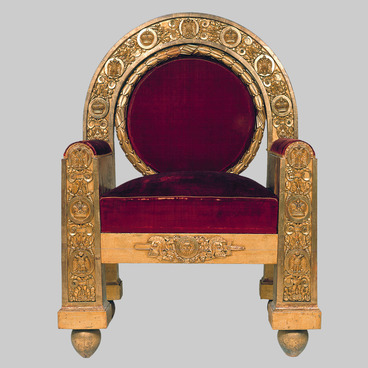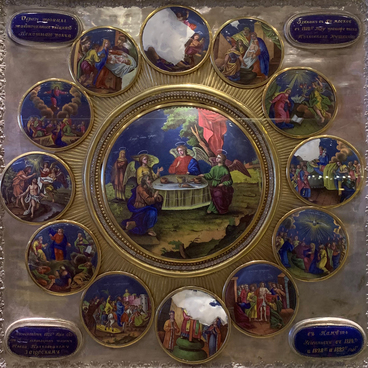The 18th century is often referred to as the golden age of European clock making. In all big countries of Europe outstanding clockmakers and workers in bronze were engaged making wall, mantel, console-based, floor clocks. By the early 19th century a clock was an indispensable part of the rich interior design imparting special charm to the interior decoration of a royal palace, residence or mansion-houses of the nobility and animating the house with its rhythmical ticking and melodious chimes. Many art styles found applications in designing the cases.
The term ‘mantel clock’ hails from England, however, thanks to the patronage of French monarchs these became most popular in France. Clockmakers of the court were considered a privileged caste working under the auspices of the king himself.
The mantel clock made by the French master Jean-Antoine Lépine exhibited in the museum is a fine example of arts and crafts. The case is adorned with a bronze sculptural composition depicting a woman with the child and a harp standing behind her back. The frontal part of the pedestal is decorated with relief with the same subject: a mother sitting at the cradle and pressing down the baby to her breast. The central medallion is encircled with an ornament of stylized palmettos, acanthus leaves, entwinements of ribbons, as well as profile portraits symbolizing Napoleon Bonaparte and Marie-Louise.
The subject of plastic art figures was not incidental – marriage of the emperor who was at the height of his glory and might in 1810 and coming-into-being of his inheritor caused a high profile political resonance and was reflected in the art. The Empire art style born in the late 18th century (from the French word empire) became a significant phenomenon for the French culture in the first third of the 19th century.
It is worth noting the words of the French emperor in forming the Empire style who said that he loves power ‘as an artist’ and is able to elicit ‘sounds, chords, harmony’ from it. The style served as a decoration of Napoleon’s cult, became personification of his political might and military glory. Re-emerging interest to the ancient Rome heritage was correlated with the achievements in politics and culture of the new Caesar.
Clocks of that period, like furniture, featured monumental, massive, strict forms which distinguished them from the works of the 18th century. The subject of antiquity dominated in décor: thus, in the clock under discussion Marie-Louise is depicted in a tunic fastened on the shoulders with agraffes.
Jean-Antoine Lépine was one of the most well-known French clockmakers and horologers. He worked in Paris on orders of Louis XV, Louis XVI, Napoleon Bonaparte and members of his family. The master made a significant contribution to the development of clock art. Among other things, he invented how to “break down” into parts the plates based on which pocket watch mechanisms were assembled and how to make several bridges with one per one or several wheels. This invention simplified the assembly and repair of pocket watches and made them thinner. The calibre of a flat pocket watch got its name to honour the inventor.
The term ‘mantel clock’ hails from England, however, thanks to the patronage of French monarchs these became most popular in France. Clockmakers of the court were considered a privileged caste working under the auspices of the king himself.
The mantel clock made by the French master Jean-Antoine Lépine exhibited in the museum is a fine example of arts and crafts. The case is adorned with a bronze sculptural composition depicting a woman with the child and a harp standing behind her back. The frontal part of the pedestal is decorated with relief with the same subject: a mother sitting at the cradle and pressing down the baby to her breast. The central medallion is encircled with an ornament of stylized palmettos, acanthus leaves, entwinements of ribbons, as well as profile portraits symbolizing Napoleon Bonaparte and Marie-Louise.
The subject of plastic art figures was not incidental – marriage of the emperor who was at the height of his glory and might in 1810 and coming-into-being of his inheritor caused a high profile political resonance and was reflected in the art. The Empire art style born in the late 18th century (from the French word empire) became a significant phenomenon for the French culture in the first third of the 19th century.
It is worth noting the words of the French emperor in forming the Empire style who said that he loves power ‘as an artist’ and is able to elicit ‘sounds, chords, harmony’ from it. The style served as a decoration of Napoleon’s cult, became personification of his political might and military glory. Re-emerging interest to the ancient Rome heritage was correlated with the achievements in politics and culture of the new Caesar.
Clocks of that period, like furniture, featured monumental, massive, strict forms which distinguished them from the works of the 18th century. The subject of antiquity dominated in décor: thus, in the clock under discussion Marie-Louise is depicted in a tunic fastened on the shoulders with agraffes.
Jean-Antoine Lépine was one of the most well-known French clockmakers and horologers. He worked in Paris on orders of Louis XV, Louis XVI, Napoleon Bonaparte and members of his family. The master made a significant contribution to the development of clock art. Among other things, he invented how to “break down” into parts the plates based on which pocket watch mechanisms were assembled and how to make several bridges with one per one or several wheels. This invention simplified the assembly and repair of pocket watches and made them thinner. The calibre of a flat pocket watch got its name to honour the inventor.



